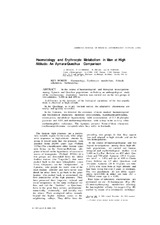Mostrar el registro sencillo del ítem
Haematology and erythrocyte metabolism in man at high altitude : an aymara-quechua comparison
| dc.contributor.author | Arnaud, J | |
| dc.contributor.author | Gutiérrez, N | |
| dc.contributor.author | Tellez, W | |
| dc.contributor.author | Vergnes, H | |
| dc.date.accessioned | 2017-04-11T12:47:47Z | |
| dc.date.available | 2017-04-11T12:47:47Z | |
| dc.date.issued | 1985 | |
| dc.identifier.uri | http://repositorio.umsa.bo/xmlui/handle/123456789/10171 | |
| dc.description.abstract | ABSTRACT. In the course of haematological and biological investigations among Aymara and Quechua populations in Bolivia, an anthropological study of the erythrocytary respiratory function was carried out on the two groups at two altitudes: 3,600 m and 450 m. A difference in the intensity of the biological variations of the two populations is observed at high altitude. In the Quechuas, as in any lowland native, the adaptative phenomena are totally and quickly reversible. In the Aymaras, we detected the existence of more marked haematological and biochemical characters: moderate polycythemia, hyperhaemoglobinemia, microcytosis, metabolical hyperactivity with accumulation of 2-3 di-phospho. glycerate and ATP, and methaemoglobinemia with a drop in the activity ofthe methaemoglobin reductases. The Aymaras preserve Sorne of those characters (methaemoglobinemia excepted) when they settle in lowlands. | es_ES |
| dc.language.iso | en | es_ES |
| dc.publisher | American Journal of Physical Anthroplogy | es_ES |
| dc.subject | HEMATOLOGÍA | es_ES |
| dc.subject | METABOLISMO ERITROCITOS | es_ES |
| dc.subject | ADAPTACIÓN A LA ALTURA | es_ES |
| dc.subject | ANTROPOLOGÍA | es_ES |
| dc.title | Haematology and erythrocyte metabolism in man at high altitude : an aymara-quechua comparison | es_ES |
| dc.type | Article | es_ES |

